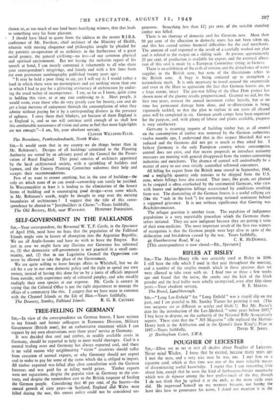ARCHITECTS IN CHAINS
Sta,—Your correspondent, Mr. A. G. Robinson, unquestionably speaks for some of our leading architects who do, I know well, feel that a civilisa-
tion cannot after all be so very advanced if, unchaining its criminals and lunatics in one century, it proCeeds to fetter its artists in the next. Let it be frankly conceded that the freedom of architects does, at the present, appear to be tiresomely limited. But will this restriction in fact prove to be very different in kind or degree from that previously imposed by the private patron? Always the architect has had to find an approving sponsor for his work and to pipe a tune acceptable to his paymaster. The days of the Burlingtons and Bcckfords being past, the well-inspired architect has, these latter years, had increasingly to educate his employer up to an appreciation of his apt solution of the problem set. Actually, for genera- tions now, the most important commissions have been in the gift, not of individuals, but of corporations, boards and committees, not neces- sarily any more enlightened than the average planning authority ; quite often probably less so.
Here then, surely, is a challenge to the public-spirited architect to widen his missionary field and, with patience and good humour, to carry his light into the surrounding outer darkness where, alas!, it has scarcely glimmered, let alone shone, these hundred years. I admit the chains, but, in the present primitive phase of our civilisation, I feel forced to accept them as preferable to a freedom for which we are as yet unfit and that we can only finally attain through aesthetic education and discipline. Dangerous? Yes, of course, as are all censorships, academic', beaux-arts and Royal Fine Arts Commissions whatsoever. Yet sometimes necessary as now, when it may be better worth while to coerce a thousand busily building weaker brethren into reasonable seemliness than to try to maintain a build-as-you-please, free-for-all convention on the off-chance that somewhere, some day, the singular exception may delight us and make architectural history with a masterpiece.
Actually, though, I see no good reason for believing that under good censorship the ingenious innovating architect is any more likely to be dis- couraged by public control in the present than he was by private prejudice in the past, whist as for going as you please, the past century has surely
shown us, as too much of our land bears horrifying witness, that that leads to something very far from pleasant.
• I should have liked to quote from the address to the recent R.I.B.A. conference of Mr. Forshaw, chief architect of the Ministry of Health, wherein with moving eloquence and philosophic insight he pleaded for the patriotic co-operation of us architects in the furtherance of a great social project, the general civilising—no less—of our common physical and spiritual environment. But not having the verbatim report of his speech at hand, I can merely commend it vehemently to all who share your correspondent's misgivings, and lamely end with a few lines from my own premature autobiography published twenty years ago:
"It may be held a poor thing to say, yet I will say it; I would rather a land in which there were no masterpieces and yet nothing mean than one in which I had to pay for a glittering aristocracy of architecture by endur- ing the usual welter of incompetence. I am, so far as I know, quite a!one in holding this view, or at any rate confessing to it. Most people, it would seem, even those who do very greatly care for beauty, can and do get a large measure of enjoyment through the contemplation of what they admire without paying for it by a corresponding distress in the presence of ugliness. I envy them their blinkers, yet because of them England is as England is, and so too will continuc until enough of us shall lose this comfortable narrowness of vision and come to feel that mere high-lights arc not enough."—I am, Sir, your obedient servant,































 Previous page
Previous page